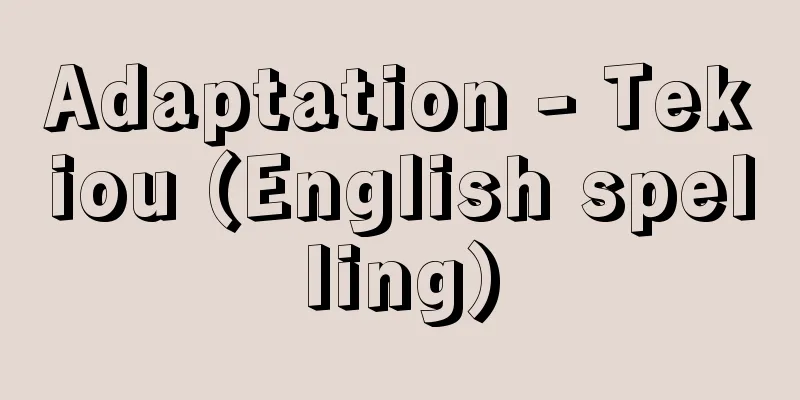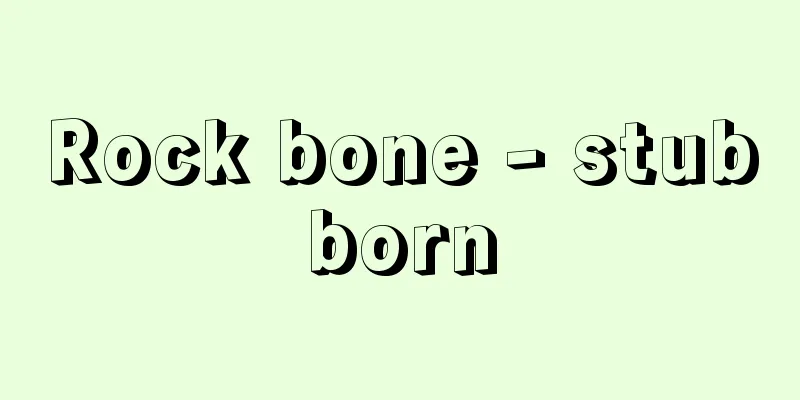Adaptation - Tekiou (English spelling)

|
It refers to the state in which an organism's morphology, physiology, behavior, and other characteristics are suitable for living in a given environment, or the process of changing to such a state. However, just because an organism is in a state that can be said to be adapted does not necessarily mean that it has adopted the form that is most suitable for the purpose of its life. Also, just because a certain characteristic is simply suitable for life does not necessarily mean that it is an adaptation. This is because it is currently customary in biology to use the word adaptation to refer to the products that organisms have acquired as a result of natural selection. [Tomoji Endo and Masayoshi Kawata] The science of adaptationIt was once thought that the purposeful nature of living things itself indicated the existence of a transcendent God. As is well known from the Paley Clock, the idea is that just as there is a watchmaker behind a clock, a complex machine with the purpose of telling time, there must be a God behind living things that have complex organs with purposefulness. In contrast to such teleological explanations, the "science of adaptation," which attempts to explain the origin of the purposefulness of living organisms through natural selection, is called teleonomy and has become a fundamental conceptual device across all areas of modern biology. The science of adaptation is established by first examining how natural selection works. Organisms cannot always be said to be in an optimal state because natural selection acts on relative fitness within the same breeding population. In other words, even if an organism is not more suitable than the characteristics of individuals in other breeding populations, characteristics that are advantageous compared to other individuals in the same population are spread throughout the population by natural selection and are considered to be adaptive. [Tomoji Endo and Masayoshi Kawata] Rationale for the adaptation viewThere are cases where it is not easy to say that the possession of a trait in an organism is advantageous for the survival or reproduction of that "individual" (the selfish individual view of fitness). The SD gene in Drosophila affects homologous chromosomes that do not have SD during meiosis, distorting the segregation ratio of sperm that do not have SD so that they are more likely to be the same. This gives the SD gene a selective advantage, but the "individual" with the SD gene suffers a disadvantage because the number of gametes formed is reduced. In other words, even though the SD gene is a kind of outlaw from the perspective of the individual, it can spread throughout the population. This shows that the unit of natural selection is the gene, and is the basis for the selfish gene view of fitness, which says that if adaptation is good for something, it is good for the gene. In general, since genes spread through the reproduction of individuals, it is expected that these two views of fitness are often not contradictory. Additionally, the properties of an individual may appear to be advantageous for the survival of the group (population or species) to which that individual belongs (the view of adaptation based on altruistic individuals). However, even if it is theoretically possible for natural selection to operate on a group basis, it is possible to understand this as adaptation from the perspective of the individual or genes. For example, in animals with territories, the increase in the population is limited, and this is often considered to have the function of preventing the extinction of the population (population-level adaptation). However, if we consider that territories have evolved to be advantageous for individuals to secure their own resources, then the phenomenon of population limitation is an incidental consequence of this and is not considered adaptation. On the other hand, it is often difficult to explain the traits of living organisms as strictly adaptive results of natural selection, and many traits are probably adaptively neutral. Attempts to find adaptive meanings in the complex patterns exhibited by living organisms are valuable in bringing about new discoveries, but it cannot be denied that they also give rise to adaptive interpretations that are difficult to verify. In reality, the science of adaptation is about exploring the constraints under which living organisms solve the problems posed by their physical and biological environments. [Tomoji Endo and Masayoshi Kawata] Psychological AdjustmentIt refers to a relationship in which not only does the organism respond to the influences of the environment, but also the organism's needs are met. However, in reality, the organism's needs are not always met. When needs are thwarted, the organism is placed in a state of frustration. Therefore, in the narrow sense, adaptation can be said to be the process of resolving frustration, and the effort to do so. The process of adaptation can be explained as four cycles: (1) motivation (desire triggers behavior toward a goal), (2) obstacle (obstruction causes behavior to stall), (3) reaction (attempt to solve the obstacle), and (4) tension resolution (discovery of a solution to the goal leads to satisfaction). Adaptation is also distinguished from acclimatization, which is specifically called social adaptation. While adaptation has a strong biological and physiological meaning in which the living organism itself changes in response to changes in the environment, adaptation emphasizes the social and behavioral aspects of the organism's actions toward the environment. [Masami Oda] "Adaptation Theory" by Kanji Hatano (included in Modern Educational Psychology Series 11, 1957, Nakayama Shoten) " "Adaptation and Desire" by Yukio Togawa (1956, Kaneko Shobo) [References] | | |Source: Shogakukan Encyclopedia Nipponica About Encyclopedia Nipponica Information | Legend |
|
生物のもつ形態、生理、行動などの諸性質が、その環境のもとで生活していくのに都合よくできていること、または、そのような状態に変化していく過程をいう。しかし、ある生物が適応しているといえる状態にあるからといって、その生物が生活上の目的にもっとも適した様式を採用しているとは限らない。また、ある形質が単に生活上適しているからといって、それが適応であるとは限らない。これは、自然選択(自然淘汰(とうた))の結果として生物が獲得した産物に対して適応ということばを用いるのが現在の生物学の慣例だからである。 [遠藤知二・河田雅圭] 適応の科学かつては、生物のもつ合目的的(目的にかなう)な性質自体が超越者としての神の存在を示すものと考えられていた。「ペイリーの時計」として周知のところだが、時を刻むという目的をもった複雑な機械である時計の背後にはそれをつくった時計匠がいるように、合目的性を備えた複雑な器官を有する生物の背後にはそれをつくった神がいるはずだというわけである。 そうした目的論(テレオロジー)的説明に対して、生物の合目的性の由来を自然選択で説明しようとする「適応の科学」はテレオノミーとよばれ、現代生物学の全領域にわたる根幹的な概念装置となっている。適応の科学は、まず自然選択がどのように働くかを調べることによって成立する。生物がかならずしも最適な状態にあるといえないのは、自然選択が、同じ繁殖集団内の相対的適応度に対して作用するからである。つまり、ほかの繁殖集団中の個体のもつ性質に比べてより適しているとはいえなくても、同じ集団内のほかの個体に比べて有利である性質は、自然選択によって集団中に広まり、適応しているとみなされる。 [遠藤知二・河田雅圭] 適応観の論拠生物のもつ形質には、それをもつことが、その「個体」の生存や繁殖に有利(利己的個体による適応観)だと簡単にいえない場合もある。ショウジョウバエのSD遺伝子は、減数分裂時にSDをもたない相同染色体に影響を与えて、SDをもたない精子の分離比に自らが多くなるようなひずみを生じさせる。そのことによって、SD遺伝子は選択上有利になるが、SD遺伝子をもつ「個体」は形成される配偶子の数が減少するため不利益を被る。つまり、SD遺伝子は個体の観点からはいわば無法者であるにもかかわらず、個体群中に広がりうる。このことは自然選択の働く単位が遺伝子であることを示しており、適応が何かにとっての善だとすればそれは遺伝子にとってであるとする、利己的遺伝子による適応観の論拠となっている。一般には、遺伝子は個体の繁殖を通じて広がるので、この二つの適応観は矛盾しないことが多いと予想される。 また、個体のもつ性質が、その個体の属する集団(個体群や種)の存続を有利にするようにみえる(利他的個体による適応観)こともある。しかし、集団を単位として自然選択が働くことも理論的にはありうるとしても、個体ないしは遺伝子の観点からの適応として理解することが可能である。たとえば、縄張り(テリトリー)をもつ動物では、個体数の増加が制限され、このことが個体群の絶滅を防ぐという機能(個体群レベルでの適応)をもつとみなされがちである。しかし、縄張りは、個体が自らの資源を確保するのに有利なために進化してきたものと考えれば、個体数の制限という現象は、その付随的結果であり、適応とはみなされない。 一方、生物のもつ形質を厳密に自然選択の結果できた適応的なものとして説明するのはしばしば困難が付きまとうし、形質のなかには適応的には中立なものも多いだろう。生物の示す複雑なパターンに、適応的な意味をみいだそうとする試みは、新しい発見をもたらすうえで価値があるが、検証のむずかしい適応的解釈を生むことも否めない。実際には、生物がいかなる拘束のもとで物理的・生物的環境の与える問題を解決しているかを探ることが、適応の科学のあり方といえる。 [遠藤知二・河田雅圭] 心理学的適応環境からの働きかけに生活体がこたえるだけでなく、生活体の側からの諸欲求も充足されている関係をさす。しかし現実的には生活体の欲求がつねに充足されるとは限らない。欲求が阻止されると生活体はフラストレーション(欲求不満)状態に置かれる。したがって狭義には、適応はフラストレーションを解消する過程であり、その努力であるといえる。 適応の過程は、(1)動機(欲求が目標への行動を惹起(じゃっき)する)、(2)障害(妨害され行動が行き詰まる)、(3)反応(妨害に対する問題解決の試み)、(4)緊張の解消(目標への解決方法が発見され満足する)、の四つのサイクルで説明される。また適応は順応と区別され、とくに社会的順応とよばれる。順応が環境の変化に伴って生活体自身が変容する生物・生理的意味が強いのに対して、適応は生活体が環境に対して働きかけることによる社会・行動的側面が強調される。 [織田正美] 『波多野完治著『適応理論』(『現代教育心理学大系11』所収・1957・中山書店)』▽『戸川行男著『適応と欲求』(1956・金子書房)』 [参照項目] | | |出典 小学館 日本大百科全書(ニッポニカ)日本大百科全書(ニッポニカ)について 情報 | 凡例 |
>>: Decius, Gaius Messius Quintus Trajanus
Recommend
Burgerliche Gesellschaft (English spelling) Burgerliche Gesellschaft
…The term “civil revolution” generally refers to ...
Single-sided drum - Katame Taiko
For example, the slit drums (split drums), repres...
Saroyan, William
Born: August 31, 1908 in Fresno, California [Died]...
Oxazolone
[Synonym] Azlactone Source: Morikita Publishing &...
Calcutta Shipping Conference - Calcutta Shipping Conference
...Cartels between shipping companies on liner ro...
Sun Yat-sen Mausoleum
The tomb of Chinese revolutionary Sun Yat-sen. Zh...
Blue clover
A perennial or annual plant of the legume family. ...
Kishi Takedo
Year of death: July 27, 1897 Year of birth: April ...
Cuff
The cuffs of a dress shirt or a dress shirt. 2. A ...
Towiański, A.
…In Paris, the greatest intellectuals of the time...
Mr. and Mrs. Oates - Otsufusai
...A prehistoric site in Iraq, located at the wes...
Parasilurus asolus (English spelling) Parasilurusasolus
...A species of freshwater fish in the Siluriform...
Kenkichi Nakamura
Poet. Born in Hiroshima Prefecture. Graduated fro...
Kochi Prefecture - Kochi
A prefecture in southern Shikoku facing the Pacifi...
Plate glass industry
Glass and glass product manufacturing accounts fo...









